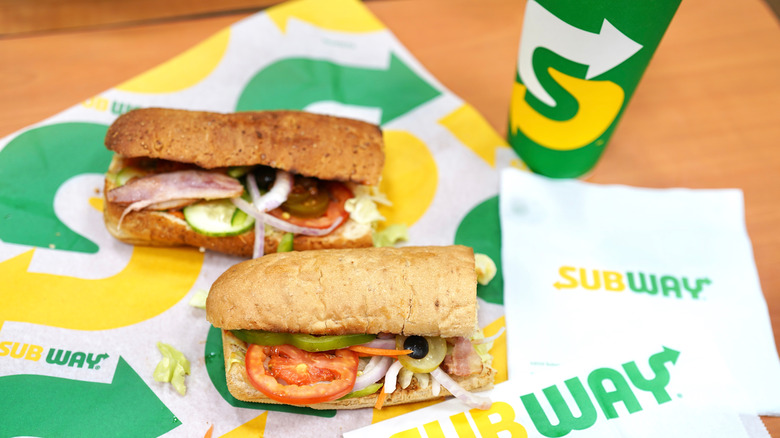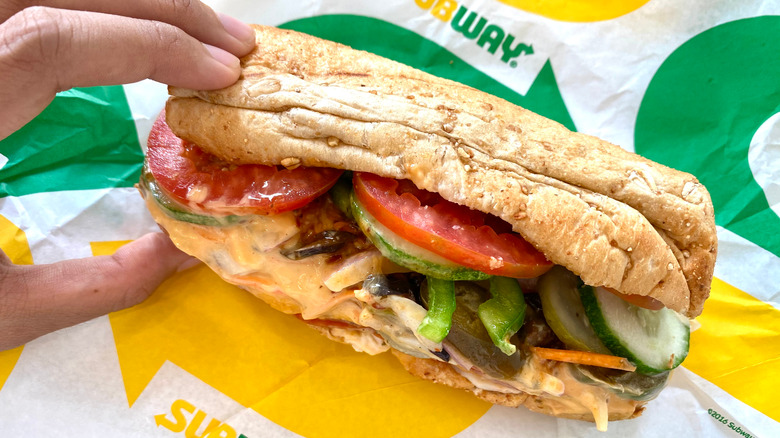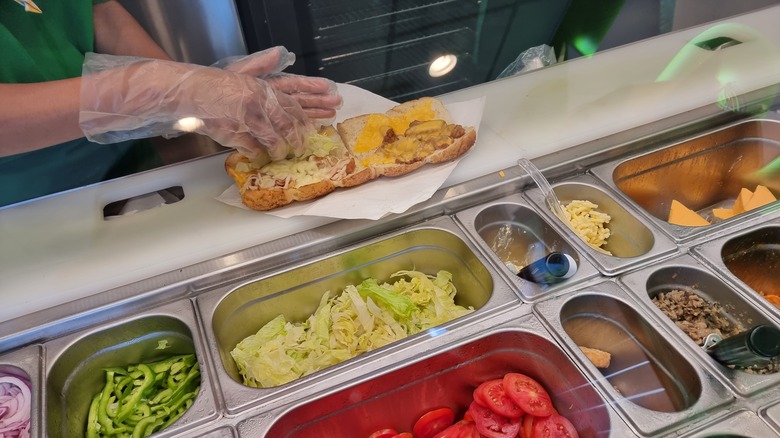The Subway Bread Controversy, Explained
You've likely experienced Subway bread at some point, whether you meant to or not. Even if you've never eaten at the global sandwich chain, you've doubtless smelled it. If you walk past one of its locations, you'll notice the air around you transforms, taking on an aroma that can only be described as, well, Subway smell. The internet is replete with theories about the smell's origins, with many, Observer among them, suggesting that it's an artificial scent vented onto the streets. Food Republic reached out to Mark Cristiano, Subway's "Global Baking Technologist," who explained that the smell comes from its bread, which is baked onsite, though the dough is made elsewhere and delivered in frozen form. Reporting from VICE suggests that Cristiano's answer is incomplete and that the smell is actually the combination of baked bread and cookies.
Cristiano's explanation opens up a whole new line of inquiry, however. That cloud of Subway air that lingers on the sidewalk in front of each location doesn't smell like any other bread in the world. That's just it, though; Subway bread isn't like other bread, and the reasons it stands out aren't exactly favorable. Over the years, Subway has faced accusations that its food is not made as advertised. For example, a lawsuit claimed that genetic testing of Subway's tuna salad found that most samples had no tuna DNA but plenty of chicken DNA, according to the Washington Post. As for its bread, it's been the subject of at least two significant controversies.
Hungry for shoe rubber?
In 2014, food blogger Vani Hari started a petition, urging Subway to remove azodicarbonamide from its bread (via USA Today). Going off the name alone, azodicarbonamide doesn't sound like it belongs in food, and in fact, Hari found that the chemical shows up in some distinctly inedible places. Azodicarbonamide is often used to increase the elasticity of rubber shoe soles, synthetic leather, and yoga mats, among other non-food items. CNN reports that azodicarbonamide can break down into urethane, which can be carcinogenic in large enough quantities though the FDA has approved low-level use in baked goods as a "dough conditioner." Inhaling azodicarbonamide can also induce asthma, a potential risk to those working in bakeries, according to the World Health Organization.
Per USA Today, Subway responded to Hari by saying it had already begun the process of removing azodicarbonamide from its products before her petition started, and completely phased it out in April 2014. However, Subway was far from the only offender in this issue. The Environmental Working Group released a report in the wake of the Subway controversy showing that almost 500 dough products made by more than 130 brands contained azodicarbonamide. These included Ball Park hot dog buns, Betty Crocker pasta salad, Hormel stuffing, and Pillsbury Toaster Strudels.
Is it even really bread?
Subway found itself in the midst of yet another bread-centric controversy in 2020 when the Supreme Court of Ireland ruled that its rolls did not meet the nation's legal definition of bread. According to The Guardian, Subway had previously filed an appeal asserting that its bread should be exempt from Ireland's Value Added Tax (VAT), a law that dictates tax policy for foods. Anything deemed a "staple food," which the Irish court considers to be bread, tea, coffee, cocoa, milk, meat, and eggs, is exempt from the VAT, while foods that are seen more as indulgences are taxed. Subway filed its appeal on the grounds that its bread was a staple food, and, boy, did that backfire.
The court ultimately ruled that Subway's bread contained too much added sugar to legally be considered bread, and that it should really be regarded as confectionery. The Guardian notes that Irish law does not allow the sugar content of bread to exceed 2% of the flour's total weight. Subway bread doesn't just exceed that limit, it soars past it, with the sugar content at 10% of the weight. Interestingly enough, Food Republic reports that the caramelization of this extra sugar during the baking process might be why Subway bread smells different than any other.


